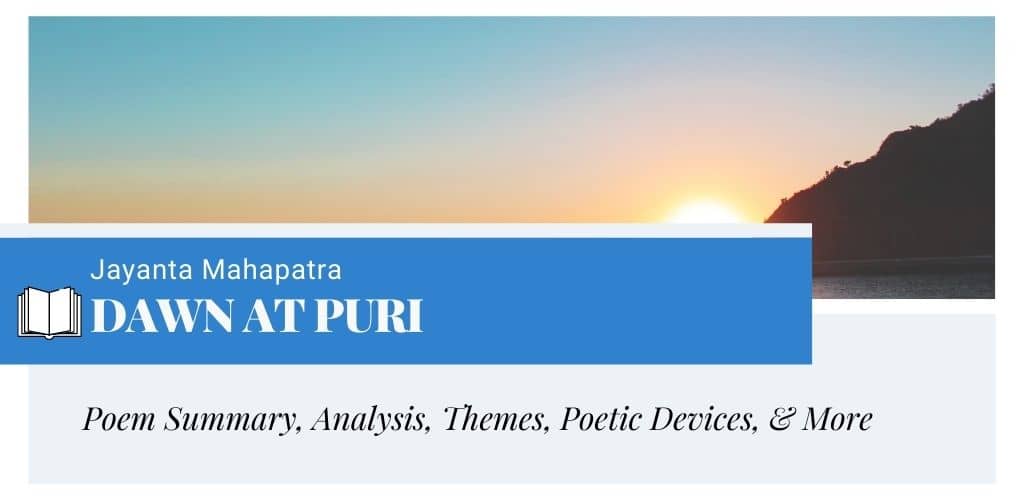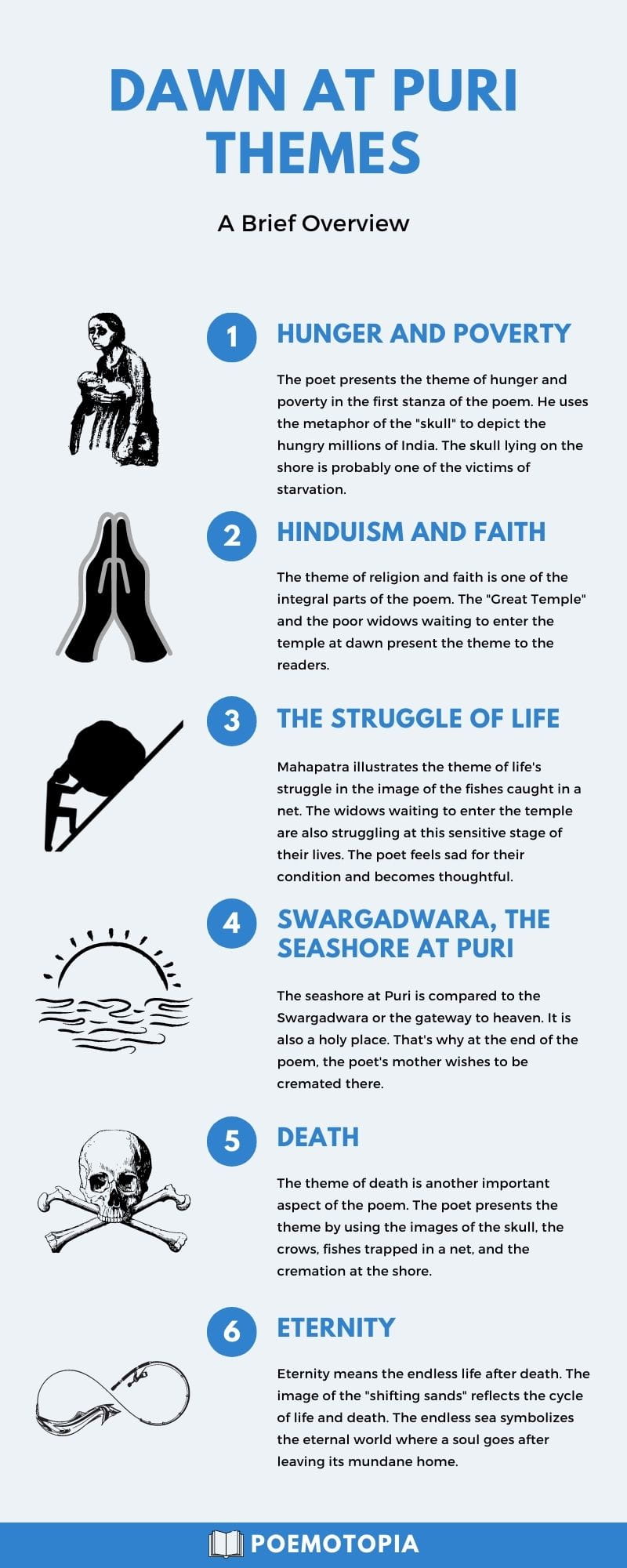Dawn at Puri by Jayanta Mahapatra
Jayanta Mahapatra’s “Dawn at Puri” is closer to the essence of Puri, located in Odisha. Puri is a city not only famous for its sandy shores by the Bay of Bengal, but also for the “Great Temple” of Lord Jagannath. Jagannath is an avatar of Lord Vishnu who is one of the deities of the Holy Trinity in Hinduism.
At dawn, seeing the orange sun rising out of its hide, spreading its frail rays all around the wet sand, is an experience to cherish for the rest of one’s life. It’s a feeling which remains silent in our hearts and gives a soothing feeling to the mind’s eyes.
In this poem, one of the pioneers of modernism in Indian English poetry, Jayanta Mahapatra shares what he sees at that patient juncture between daybreak and night. This poem is not a general spectacle of the sea beach. It’s much more than that. It’s about life and its ebbs and tides.
- Read the full text of “Dawn at Puri” below:
Dawn at Puri by Jayanta Mahapatra Endless crow noises A skull in the holy sands tilts its empty country towards hunger. White-clad widowed Women past the centers of their lives are waiting to enter the Great Temple Their austere eyes stare like those caught in a net hanging by the dawn's shining strands of faith. The fail early light catches ruined, leprous shells leaning against one another, a mass of crouched faces without names, and suddenly breaks out of my hide into the smoky blaze of a sullen solitary pyre that fills my aging mother: her last wish to be cremated here twisting uncertainly like light on the shifting sands. - from A Rain of Rites (1976)

Glossary
- tilt: bend
- White-clad: wearing a white saree; Hindu widows wear such sarees
- centers: middle-aged
- austere: plain, simple; without having the natural spark
- strands: seashore
- frail: weak; dim
- ruined: decayed, collapsed
- leprous: suffering from leprosy, a type of skin disease
- leaning: sitting in a tilted or bent position with support
- crouched: sitting with bent knees and the upper body is brought forward and down
- sullen: in a depressed mood
- solitary: lonely
- pyre: a heap of wood for burning dead bodies
- cremated: disposing of dead bodies by burning
Summary
The poetic persona of “Dawn at Puri” shares what he sees at dawn on the Puri sea beach. Numerous crows are gathering on the beach. Apart from the crows, he observes a human skull lying. The skull reminds him of hunger and poverty prevalent in his state Odisha.
Then the poet shifts his view to somewhere else. He now looks at the “Great Temple” of Jagannath. Pious old widows who are “past the centers (50 years) of their lives”, are waiting to enter the temple.
The passive look in the widows’ eyes grabs his attention. He can find a similarity between their eyes and the eyes of the fishes caught by the fishermen.
Mahapatra’s speaker looks back at the seashore. This time he observes some shells in the “frail early light” of dawn. Again the similarity strikes him. He finds the image of the widows is reflected in those motionless shells.
Suddenly the “smoky blaze” of cremation on the beach comes to his attention. The smoky smell makes the speaker’s aging mother aware of her mortality.
In the last stanza, he refers to her mother’s wish. She wants to be cremated at her native place which is undoubtedly the town of Puri.
Form, Meter, and Rhyme Scheme
Form
There is an interesting pattern in the poem’s structure. The stanzas reflect the waves. Readers have to imagine the lines of the poem as seawater. They have to closely observe the first four stanzas of the poem. These stanzas depict a wave hitting the shore.
The last two stanzas show that the water is receding back to the sea. In this way, Jayanta Mahapatra depicts life and death visually through the poem’s structure.
This poem is all about life. Life is like seawater. It comes to the shore, stays temporarily, and returns to the sea again. In between our feet what stays, are the remnants of life. Those formless artworks on the sand are what human beings leave behind.
Whatsoever, “Dawn at Puri” is a free-verse lyric poem. It is told from the perspective of a first-person speaker. The speaker is Mahapatra himself. He depicts what can be seen at dawn on the Puri sea beach.
Meter
Scansion helps us to understand the sound pattern of a poem. It also suggests the mood of the poem and how one should read the text. “Dawn at Puri” opens a package of metrical composition. Those who have visited a beach and heard the sea’s sound will help understand the concept easily.
Read this line with attention to the sound:
End-less/ crow noi/-ses
It sounds like a wave is approaching. The falling rhythm imitates this sound.
Read the next line:
A skull/ in the ho/-ly sands
This time the wave is bigger than the previous one.
In the third line, the wave is receding.
tilts its/ emp-ty/ coun-try/ to-wards/ hung-er.
This scheme with little alterations follows the next three stanzas.
The change of sound pattern occurs in the last two stanzas as the mood of the poem changes there. For instance, the first line of the last stanza reflects a deep sound like the sea.
her last wish/ to be cre/-ma-ted here
It sounds like the waves are far from us and approaching slowly.
In the next line, the sound becomes lower as the line lacks a syllable.
twis-ting/ un-cer/ tain-ly/ like light
In the last line, the sound fades slowly.
on the shif-/ -ting sands.
The flow of the poem changes in this pattern. Mahapatra was not only writing this poem but he was also giving it a body, a soul, a brain, and most importantly a heart! What an excellent piece of art!
Rhyme Scheme
This piece is written in free-verse. That’s why there is not any specific rhyme scheme. Mahapatra uses internal rhyming in the lines. For this purpose, he uses repetition of similar consonant and vowel sounds. As the lines are interconnected, the flow does not break in the middle.
Poetic Devices & Figures of Speech
Figures of speech are the abstract ornaments of any poem. Rhetorical devices adorn poetic thoughts and make the poet’s imagination vibrant in readers’ minds. Let’s have a look at the poetic devices used in “Dawn at Puri”.
Metaphor
- “White-clad” is a metaphor for the white saree worn by Hindu widowed women.
- “past the centers of their lives” is another metaphor. It means that the widows have passed the age of fifty.
- The phrase “dawn’s shining strands of faith”, contains a metaphor. Here the sunlight at dawn is compared to a ray of faith. The dawn is also a stock symbol of hope.
Personal Metaphor
- The phrase “leprous shells” is an example of a personal metaphor. The poet tries to compare the old widows to the shells lying on the shore by this phrase.
- “sullen solitary pyre” contains the use of personification or readers can say it is an example of a personal metaphor. Here the pyre is compared to a solitary person in a depressed mood.
Simile
- In the line “stare like those caught in a net,” the poet compares the widows’ eyes to the eyes of the fish caught in a net.
- Mahapatra compares the twisting of her mother to the “light on the shifting sands” in the last stanza.
Metonymy
- The “skull” is a metonym for poverty and hunger. These problems still haunt the poor.
- The phrase “empty country” is a metonym for the people living in India. Here the poor people of India are hungry or their belly is empty. The variety of metonymy used here is “container for the thing contained”.
- “Great Temple” is a symbol of religion. It is a reference to the Jagannath Dham of Odisha.
Enjambment
It occurs throughout the poem. In each tercet, the lines are enjambed. For example, in the first tercet, the lines are connected and they form a single line. Mahapatra also uses this device to connect the stanzas. For instance, let’s have a look at the last line of the fourth stanza and the first line of the fifth stanza. These lines are enjambed. The poet uses it to maintain the flow throughout the text.
Other Literary Devices
- Extended Metaphor: The phrase “a mass of crouched faces without names” is an extended metaphor of the old widows.
- Synecdoche: The phrase “austere eyes” is an example of synecdoche. Here the poet associates the widows with only their eyes.
- Personification: Mahapatra personifies the early light of the dawn and invests it with the idea of catching.
- Hyperbole: “Endless crow noises” contains hyperbole.
Line-by-Line Analysis and Explanation
Lines 1-3
Endless crow noises
A skull in the holy sands
tilts its empty country towards hunger.
Mahapatra uses a set of images in every stanza and it proves that it is a perfect example of an imagist poem. Let us decode each visual element available in the text.
In stanza one, the first image which appears in front of us is of numerous crows gathering at the beach of Puri. At dawn, we can see the exact image. Why are the crows sitting there? The next line has the answer. There is a human skull. As the crow is called the “scavenger of nature,” readers can understand the rest.
This human skull doesn’t evoke fear in the poet’s mind rather it evokes a sense of despair. Mahapatra thinks about the person who has died out of hunger. The problem of hunger among the poor millions of India is not an issue occurring only in Odisha, it is a problem of the whole country. It projects the reality behind the so-called development at that time.
Lines 3-6
White-clad widowed Women
past the centers of their lives
are waiting to enter the Great Temple
In the second stanza, the poet presents another image. Now he shifts his view from the seashore to the “Great Temple”. Some old widows waiting to enter the temple particularly come to the poet’s attention. They are waiting to get a glance of the deity. Those women are past their centers of life. It means they are above fifty. There is nothing left in their heart except hope and faith. It is not a worldly hope or desire, it is the yearning for “Moksha” or salvation.
The first line of this tercet “White-clad widowed Women” contains an alliteration of the “w” sound. This repetition of similar sounds creates an internal rhyming. Mahapatra uses enjambment to internally connect the lines. Besides, he capitalizes the first letter of “Women” for the sake of emphasis.
Lines 7-9
Their austere eyes
stare like those caught in a net
hanging by the dawn’s shining strands of faith.
The poet is touched by the thought of the widows. He goes on to portray their condition in the mentioned stanzas. There is also a reason behind that. It will be clear to the readers in the fifth stanza.
In the third stanza, the emotional eyes of the widows make the poet sad. He thinks they are “caught in a net” and hanging. To describe their condition, Mahapatra uses a simile of the fishes caught by a fishing net. He can find a similarity between their eyes. They want freedom from the “net” of life. This net symbolizes the rigid customs of Hinduism and at the same time poverty and helplessness.
In this same stanza, there is a metaphor of the seashore. It is used to ironically portray the condition of the widows. A new day is beginning. But, “by the dawn’s shining strands of faith”, those poor creatures are suffering in their hopeless state.
Lines 10-12
The fail early light catches
ruined, leprous shells leaning against one another,
a mass of crouched faces without names,
In the next stanza, the poetic persona finds some shells on the beach. He thinks that they are like “a mass of crouched faces without names.” These faces are of the widows sitting outside the temple. They do not have names. Reality has driven them into such a condition that their suffering has become identical but the representation differs from person to person.
There is an interesting point to note here. Why does the poet use the image of “shells”? The mollusks leave their shells when they mature. What happens to those shells? They are left behind carelessly on the shore. The condition of the poor widows is similar to the shells.
Lines 13-15
and suddenly breaks out of my hide
into the smoky blaze of a sullen solitary pyre
that fills my aging mother:
In this section of the poem, Mahapatra suddenly shifts the mood towards something solemn and sincere. It is death, the finale of human life.
The “smoky blaze” of a cremation ceremony catches the poet’s attention. The pyre seems to the poet as a “sullen solitary” figure. It is not solitary. But the dead person who is being cremated is lonely.
The sound of burning woods makes the poet imagine that the personified “pyre” is in a bad temper. His mother is lying beside her. She has also seen the smoke. In the following section, Mahapatra focuses on her thoughts.
Lines 16-18
her last wish to be cremated here
twisting uncertainly like light
on the shifting sands.
In the last stanza of the poem, the poet’s mother’s attitude towards death is remarkable. The smoke of the pyre makes his mother aware of her mortality. But she is not afraid at all. She wishes to die at her native land, Puri, and desires to transcend into eternity like the “light on the shifting sands.” The reason is very simple. She has a long and deep relationship with Puri. For this love, she doesn’t want to leave the place even at the time of her death. Such attachment keeps her bound to the place that nourished her throughout her life.
Themes
The poem “Dawn at Puri” consists of various themes. Each theme is closely associated with Indian culture and most importantly with Puri. The major themes of the poem are easily accessible and understandable. Let us have a look at the themes which play a major role in this piece.
An Infographic of “Dawn at Puri” Themes

Hunger and Poverty
The theme of hunger and poverty is one of the major themes of the poem. The first few lines depict a sense of morbidity. In the first tercet, the “skull” is nothing but a manifestation of the country. What does the skull signify?
A skull provides mechanical support to the brain. It acts as a shield and protects the sensitive part. Without having anything inside, it becomes a useless thing. The condition of India appears to the poet as a mere structure just protecting the countrymen. The essential nourishment for survival is absent in the country. That’s why the suffering of the poor is symbolically portrayed through the image of the skull. The issue of hunger is closely associated with it.
Apart from physical poverty, the poet also touches on mental poverty. Hopelessness in the eyes of the widows and the void inside their souls signify their mental poverty. Most Indians belonging to the lower section of the society feel hollow inside their heart. They move on with hope. In reality, nothing has changed in their lives. What remains, prolongs their suffering. Unfortunately, they pass it from generation to generation.
Hinduism and Faith
Another important theme of the poem is religion and faith. There is no doubt that the poet talks about Hinduism. Another component is faith which has a global reach. Boundaries cannot stop people from believing or having faith in the omnipotent.
The old women sitting outside the temple have the same ray of hope in their eyes. The string of Hinduism keeps them together. When they have nothing to lose or nothing to gain at this stage of their lives, the only source of nourishment is getting salvation.
The “Great Temple” has significance in this discussion. It is a source of divine inspiration. Its existence helps their souls to thrive. They thrive each day for a glance of Lord Jagannath. He is one of the deities in the Hindu religion but for them, he is the only source of hope. Their faith is centered on Jagannath only. His sole presence makes them believe that they have to walk a long way before the metaphorical night of life.
The essence of religious faith in this way becomes a uniting factor in the poem. It is needless to say, religion binds Indians together. That’s why there is “unity in diversity”.
The Struggle of Life
In “Dawn at Puri,” Mahapatra portrays the struggle of life in an innovative manner. He associates the idea by using a simile of the “fishes caught in a net”. They have the desire to live. In their eyes, there is hope. Like these poor creatures, the widows are also caught in a net. This net is invisible. It is the chain of life.
Society, poverty, and loneliness hold them in this chain. They do not dare to break the shackles. It also seems that they do not have the energy to do so.
However, they know how to unburden themselves at the feet of Jagannath. Their eyes reflect an urge. The depth in those eyeballs says much more than mortal eyes can see. Mahapatra depicts their struggle to keep themselves alive.
Swargadwara, the Seashore at Puri
The importance of the sea beach of Puri is immense. Mahapatra uses it as a replica of human life. It is not a unique symbol but the idea of Indianness is novel. He portrays the sea beach as a representation of life.
The crow cawing at dawn. Beside them, the skull lies nowhere but on the beach. The reason is simple. For the poet, the sandy shores reflect a borderline between life and death. The vast and unending sea symbolizes life after the death that mortals are unaware of.
In between the city and the massive water body lies the “Swargadwara” of human life, the eternal seashore. It is a place where everyone is destined to come one day. What remains is the crouching seashells, symbolizing our bodies. The soul leaves the bodily shell and starts a new journey shown by the sea. In this way, the sea is transformed into a gateway to heaven.
Death
This theme is present from the beginning to the end. Each image associated with the theme of death reveals interesting ideas. For example, the skull at the beginning can be of a person who died of hunger. This image depicts the ruthlessness of life.
Thereafter the fishes caught within a net foreshadows death. The fishes are compared to humans and how they are also caught in the net of worldliness.
The empty seashells reflect another idea. This image reflects the lifeless human bodies. The idea of the soul leaving the old clothes and getting new ones is present there. The shells also reflect the condition of the widows.
Eternity
The theme of eternity is present in the last few lines of “Dawn at Puri”. Here, the speaker’s mother wishes to be cremated on the shore. Her wish reflects how much she loves her native place. Besides, the seashore at Puri is seen as a gateway to heaven. That’s why she wishes to die there.
The image of cremation hints at the cycle of life. It is eternal and timeless. It reflects how a soul leaves the body. Like the “shifting sands”, human life is also transient. The soul leaves its physical house or the body without anyone’s notice. Then it sets out for eternity.
The sea is a symbolic representation of life after death. Nobody knows how wide the sea is. None can calculate its depths. Similarly, there is no way to know what is there after death.
At the shore, land meets the sea. Therefore it symbolizes the juncture between life and death. In popular beliefs, the shore is the place where the soul seeks “Nirvana” or salvation. Thereafter it is permitted to heaven. Now it can be understood why the speaker’s mother wishes to die there.
Imagery
“Dawn at Puri” is vivid in imagery and spontaneous in diction. Let’s explore the imagery used in this poem.
- Auditory Imagery: The poem begins with the use of auditory imagery. In the first line, the poet depicts the noise of the crows. Moving on to the last few lines, he depicts the sound of the solitary pyre and the sea waves.
- Visual Imagery: This poem is filled with several visual images. It portrays what one can see on the seashore at dawn. The poet depicts crows, a skull, the “Great Temple”, a group of widows, a cremation pyre, etc.
- Organic Imagery: It can be found in the following lines: “stare like those caught in a net/ hanging by the dawn’s shining strands of faith.” Here, the poet describes how the dawn evokes faith in his heart.
- Olfactory Imagery: The line “into the smoky blaze of a sullen solitary pyre” contains an image related to smell.
- Kinetic Imagery: This device is present in the last two lines of the poem. Here, the poet describes the movement of light on the shifting sands.
Historical Background
Though Mahapatra willfully rejects the conventional poetic decorum, still he is successful in making the poem “Dawn at Puri” a well-organized specimen of art. His Odia origin is in the poem’s blood and his sense of Indianness is in its spine. He taps on the social concerns of poverty and hunger through this piece. At the same time, it touches on some philosophical aspects and a sense of eternity at the end of the poem. In totality, this poem depicts several issues that were prevalent in India at the time of writing this poem.
Jayanta Mahapatra is the first Indian English poet to win a Sahitya Akademi award. He was also awarded the Padma Shri in 2009. However, he returned the title in 2015 for the rising intolerance in India. His poems address the issues of his country and tap on some deeper philosophical concepts as well.
Questions and Answers
“Dawn at Puri” is an imagist poem as it contains a variety of imagery. Firstly, it begins with auditory and visual imagery to depict the scene. Thereafter, he goes on to present a set of visual images to describe various ideas related to life, death, and suffering.
The line “Endless crow noises” contains onomatopoeia. This line depicts what one can see on the shores of Puri at dawn. Mahapatra uses the hyperbolic expression “Endless” to signify that the ceaseless sound the crows make.
The central idea or theme of this piece concerns the cycle of life and death. It also beautifully describes the scenes that can be seen at dawn on the Puri seashore.
In the last verse of “Dawn at Puri,” Mahapatra says that his mother’s last wish is to be cremated on the shores of Puri. She is going to die like the uncertain light, on the shifting sands.
Jayanta Mahapatra’s “Dawn at Puri” was published in his book of poetry A Rain of Rites in 1976.
The poem consists of six tercets or three-line stanzas.
The poet’s mother wants to be cremated by the holy shores of Puri.
Similar Poems about Death
- “After Death: Twenty Years” by Birendra Chattopadhyay – It’s a poetic address to Rabindranath Tagore concerning the incidents occuring before and after the partition.
- “Death the Leveller” by James Shirley – This poem centers on the egalitarian nature of death.
- “My Mother at Sixty-Six” by Kamala Das – This poem describes how a speaker leaves her aging mother. It taps on the themes of death, aging, and relationship.
- “Equinox” by Elizabeth Alexander – This metaphorical poem explores the themes of old-age, death, and life.
External Resources
- Check Out The Poetry of Jayanta Mahapatra — Explore this invaluable book on mahapatra’s poetry.
Biography of Jayanta Mahapatra — Learn about the poet’s biography and his works. - About Jayanta Mahapatra — Read more about the poet and explore some of his well-known poems.
- In a chat with Jayanta Mahapatra — Read the full interview of the poet with Jaydeep Sarangi.
- Interview with Jayanta Mahapatra — Learn more about the “grand old man of Indian literature.”
- 10 of the Best 20th Century Indian Poets — Read how R. Parthasarathy evaluates Jayanta Mahapatra.
- “Something in me refuses to die,” an Interview with Jayanta Mahapatra — Explore what keeps the celebrated Odia poet going.






